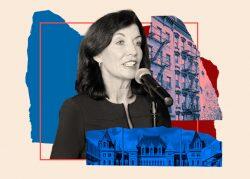Albany is a land of mixed blessings.
Real estate was reminded of that as lawmakers laid out budget priorities that included more rent aid and housing vouchers but no 421a tax break or density increase for residential development.
The Senate and Assembly over the weekend called for at least $1 billion to replenish the state’s Emergency Rental Assistance Program. Senate Democrats want the money to cover rental arrears when tenants have refused to apply for aid. The funding would be a fallback in case the state does not receive $1.6 billion in federal funds requested by Gov. Kathy Hochul.
Both chambers also proposed a $250 million voucher program similar to Section 8 for New Yorkers who are homeless or at risk of becoming so.
In her executive budget proposal, Hochul set aside $2 billion for pandemic-related relief, including rental aid. A spokesperson for Hochul would not specify whether the governor supports legislators’ requests, but said she would continue working with them to finish the budget, which is due April 1.
Landlord groups praised the call for rent aid and the new voucher program.
“For months, we cautioned that the federal funds originally allocated for New York fell far short of meeting the needs of the nation’s largest population of income-burdened tenants,” Joseph Strasburg, president of the Rent Stabilization Association, said in a statement. “This proposed budget will provide the funds needed for qualified tenants to meet their rental obligations.”
The one-house budget resolutions are not binding, but provide insight into where lawmakers stand as negotiations heat up.
Read more

Both chambers excluded the governor’s proposal to replace 421a with a similar property tax incentive, dubbed 485w. Lawmakers have expressed concern that Hochul’s measure would not produce enough deeply affordable housing. Tenant advocates do not want 421a replaced when it expires June 15.
In an election year for all state offices, Albany lawmakers have largely refrained from endorsing the controversial tax break’s revival. But they can use the prospect of their support as leverage to get their own priorities into the budget.
James Whelan, president of the Real Estate Board of New York, said in a statement that he is “confident that the governor’s proposal will be included in her final budget later this month.”
The last time 421a expired, in early 2016, construction labor groups played a key role in shaping its replacement. That is shaping up to be the case again. A key issue is whether “average” or “prevailing” construction and service workers’ wages will be required to qualify for the tax break.
The New York City District Council of Carpenters is pushing for prevailing wage provisions in the governor’s program, rather than the average minimum rates introduced in the 2017 version. The union does not want those wage requirements limited to certain projects; Hochul’s plan would apply them only to projects larger than 300 units in certain parts of Manhattan, Brooklyn and Queens.
The Building and Construction Trades Council demanded prevailing wage as a condition of renewing 421a in 2017, but eventually reached an agreement with REBNY to establish average wage requirements.
Since then, and following another clash with developers in Hudson Yards, the trade group, led by Gary LaBarbera, and REBNY agreed to work together on policy issues where their interests align. Both want 421a renewed by developers prefer flexibility on wages. LaBarbera could not be reached for comment.
Building service workers union 32BJ SEIU, a key player in Albany politics, supports the governor’s 485w proposal, which requires its members to be paid prevailing wages on projects with 30 or more units.
“Thousands of 32BJ members also currently live in affordable units in 421a buildings,” Kyle Bragg, president of SEIU 32BJ, said in a statement. “The worst thing we can do is to let the program expire without a replacement in place and see both good jobs and affordable housing production fall off a cliff — stripping our communities of much-needed affordability and leaving workers in the lurch.”
The Senate and Assembly proposals also excluded the governor’s changes to the floor area ratio cap for residential buildings. The governor would allow New York City to lift the cap above 12 for residential buildings.
Both chambers also left out proposals to make it easier to convert offices and hotels to residential use. Instead, they are pushing for further support of the Housing Our Neighbors with Dignity Act, which was approved last year with limited funding.
The two budget resolutions also omitted the governor’s proposal to bar landlords from automatically rejecting prospective renters with criminal records.
The Senate also called for faster electrification of buildings. The governor’s bill would mandate that new buildings produce zero carbon emissions by 2027. The Senate’s resolution, citing a pending state bill, would move the deadline up to 2024. The industry calls that impractical.
